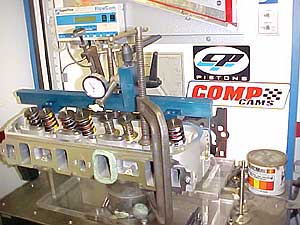|
Project Muscrate
Part 2: Head
games
by Jay Roeder
www.roederperformancemachine.com
2/12/04
Hi everyone,
it's time to get to work. This installment of
Project Muscrate will cover the cylinder heads
that I am using, and what can be legally modified,
as per IHRA rules, to increase performance,
meaning flow.
 The
302/320 hp Ford crate engine comes from Ford
with a pair of GT-40 Turbo Swirl aluminum cylinder
heads. Now before anyone gets too excited, the
only thing "turbo" about these heads is the
name. In fact, they are moderate street/strip
style heads with rather uniquely shaped combustion
chambers designed to promote "swirl" within
the chambers and provide a more efficient burn
during combustion. The
302/320 hp Ford crate engine comes from Ford
with a pair of GT-40 Turbo Swirl aluminum cylinder
heads. Now before anyone gets too excited, the
only thing "turbo" about these heads is the
name. In fact, they are moderate street/strip
style heads with rather uniquely shaped combustion
chambers designed to promote "swirl" within
the chambers and provide a more efficient burn
during combustion.
That being said, what do they flow, you ask? The answer is, not as much as they are supposed to. The problem with flow numbers from all manufacturers is they tend to be way too optimistic about the published flow numbers of a particular head. The problem for me, as an engine builder, is that I have a SuperFlo computerized flowbench and I know the truth about what a head flows at a given lift at a given pressure drop. I am continuously aggravated.
For instance, I have just completed a 406 SBC customer engine that I used aftermarket iron heads on. When I initially planned this guy's project, I looked at the advertised flow numbers for these heads -- 307 cfm at 28 inches of pressure drop. Knowing how things usually work, I figured that in the real world they would probably flow about 25 cfm less than advertised. WRONG! How does 262 cfm at 28 inches strike ya? That's 45 cfm less than advertised! You have to watch these things.
My heads for the Muscrate engine, on the other hand, were supposed to have
an intake flow of 240 cfm at .550" lift at 28
in. drop and the exhaust numbers were advertised
at 170 cfm at .500" lift. In the real world
however, (on my SuperFlo bench) they peak out
at 221 cfm intake @ .600" lift and the exhaust
peaks at 141.30
ADVERTISEMENT
 |
cfm
@ .600" lift. Both numbers were, of course,
measured at 28-in. pressure drop. Why all manufacturers
list their respective flow numbers higher than
you or I will ever see, out of the box anyway,
is a story all by itself and may be a topic
for another column in the future.
The main piece of advice I would give to the
consumer when trying to decide which pair of
aftermarket cylinder heads to choose, is to
seek the advice of a reputable engine builder
and ask if they have ever flowed the particular
heads you are interested in. Also, keep in mind
that PEAK flow numbers are almost meaningless.
Peak flow is a number that some people like
to throw out during the deep discussions we
all have had about our favorite thing, horsepower.
The person that has the best mid-lift flow and
average flow is always going to be the winner
in the real world.

|